For many years, concerns about Upstate New York’s relatively slow economic growth have revolved around the idea that the region’s performance has been subpar, and that by altering government policies, by reducing tax burdens, or by spending money on economic development projects, performance could be improved.
But these analyses ignore the fact that Upstate’s economic performance is largely the result of its historic industry mix, which emphasized manufacturing in the past, its location and its age. All of these factors have worked to make the region less competitive as a location than it once was.
In fact, from the perspective of personal income, upstate metropolitan areas are doing a little better than comparable rust belt cities. Each of the large Upstate metropolitan areas, other than Utica-Rome had a median family income in 2013 that is higher than that of rust belt cities outside New York, on average, or for the United States ($64,719).
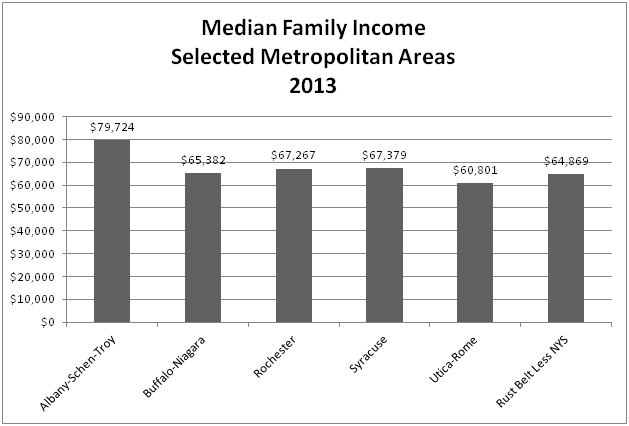 While residents of Upstate metropolitan areas are doing relatively well, Upstate New York metropolitan areas are distinctive for the amount of economic segregation that exists between the economic fortunes of city residents and those of suburban areas surrounding the cities. In all but one (Albany) Upstate city, incomes of families average a smaller percentage of what suburban families earn than the average of rust belt cities outside New York State. In the most extreme case, the Rochester metropolitan area, city families earn only half of what suburban residents earn.
While residents of Upstate metropolitan areas are doing relatively well, Upstate New York metropolitan areas are distinctive for the amount of economic segregation that exists between the economic fortunes of city residents and those of suburban areas surrounding the cities. In all but one (Albany) Upstate city, incomes of families average a smaller percentage of what suburban families earn than the average of rust belt cities outside New York State. In the most extreme case, the Rochester metropolitan area, city families earn only half of what suburban residents earn.
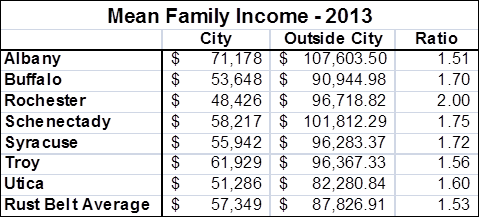 The poor economic condition of Upstate city residents can also be seen by looking at poverty statistics. Other than in the Albany- Schenectady-Troy metropolitan area, Upstate cities have higher percentages of poor people than the rust belt average, with more than 30% of residents living in poverty. In contrast, the percentage of poor people in suburban areas outside cities is very low, well below 10% in all cases except Utica, compared with the rust belt average of 10.5%. Of the 841,636 people who lived in Upstate cities in 2013, 256,973 lived in poverty, while of the 2,037,889 people who lived in the counties outside the central cities, only 160,313 lived in poverty. As a result, the percentage of people in poverty in Syracuse and Schenectady is more than five times higher than in the suburbs, compared with three times higher in rust belt cities outside New York State.
The poor economic condition of Upstate city residents can also be seen by looking at poverty statistics. Other than in the Albany- Schenectady-Troy metropolitan area, Upstate cities have higher percentages of poor people than the rust belt average, with more than 30% of residents living in poverty. In contrast, the percentage of poor people in suburban areas outside cities is very low, well below 10% in all cases except Utica, compared with the rust belt average of 10.5%. Of the 841,636 people who lived in Upstate cities in 2013, 256,973 lived in poverty, while of the 2,037,889 people who lived in the counties outside the central cities, only 160,313 lived in poverty. As a result, the percentage of people in poverty in Syracuse and Schenectady is more than five times higher than in the suburbs, compared with three times higher in rust belt cities outside New York State.
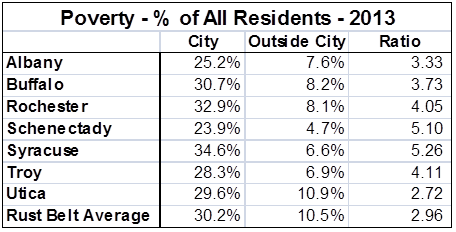 The economic condition of families with children in Upstate cities is of even greater concern. In Rochester and Syracuse, nearly half of families with children live in poverty, while in Buffalo, Utica and Troy the percentage of poor families with children is greater than 45%. In contrast, about 10% of families with children in the suburbs around upstate cities were poor. 92,574 of the 198,549 children under 18 living in the upstate cities lived in poverty in 2013. Outside the cities in the surrounding county, 43,808 of the 437,728 children under 18 lived in poverty. The percentage of families with children living in Syracuse, Rochester, Schenectady and Troy was more than five times higher than in the suburbs, compared with a difference of less than three times in rust belt cities outside New York State.
The economic condition of families with children in Upstate cities is of even greater concern. In Rochester and Syracuse, nearly half of families with children live in poverty, while in Buffalo, Utica and Troy the percentage of poor families with children is greater than 45%. In contrast, about 10% of families with children in the suburbs around upstate cities were poor. 92,574 of the 198,549 children under 18 living in the upstate cities lived in poverty in 2013. Outside the cities in the surrounding county, 43,808 of the 437,728 children under 18 lived in poverty. The percentage of families with children living in Syracuse, Rochester, Schenectady and Troy was more than five times higher than in the suburbs, compared with a difference of less than three times in rust belt cities outside New York State.
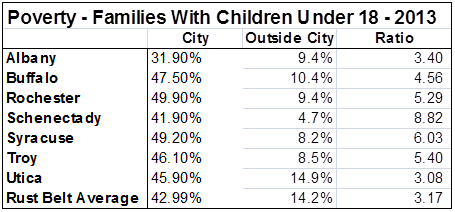 The Growth of Poverty in Upstate Cities
The Growth of Poverty in Upstate Cities
Poverty in Upstate cities grew twice as fast as in the nation as whole, and almost five times as fast as in the suburbs around those cities between 1999 and 2013. The percent of families with children living in poverty grew by 7% nationally. But the fortunes of upstate city residents were far more adversely affected by poverty than suburban residents during the period. Poverty in families with children in Upstate suburbs grew by an average of 3.3% during the period, while in Upstate cities, poverty grew by 15.3% on average, growing by 17.5% in Rochester, 18.1% in Syracuse, and 23.9% in Troy.
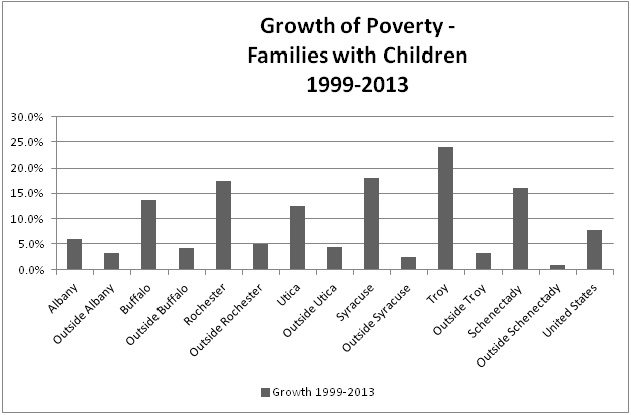 Implications
Implications
Efforts to help Upstate New York have, in the past, focused on reducing taxes and creating economic development funds to provide resources to promote regional economic growth. Governor Cuomo’s Upstate Revitalization Initiative encourages the development of Regional Economic Development Councils which have been tasked with the development of strategic plans in competitions for state economic development funds. The program could be potentially beneficial to the Upstate region, if projects are chosen well, and implemented as promised.
But regional strategies do not focus on the needs of the people of Upstate cities who have been hardest hit by the growth of poverty over the past fifteen years. Cities are home to people who compete least effectively for good jobs, because of weak educational backgrounds, high percentages of single parent households, criminal records, transportation difficulties and the like. For those reasons, traditional economic development or tax incentive strategies are unlikely to significantly benefit them. Instead, state leaders should develop strategies that are designed to directly address the obstacles that prevent city residents from getting good, full time jobs.
Webmentions
[…] own research showed that upstate cities have increasingly high poverty rates – in Syracuse and Rochester, for example, more than 50% of children under 18 live in poverty, […]